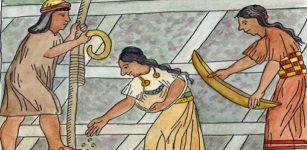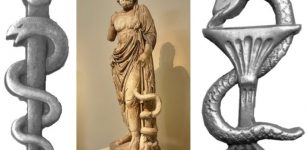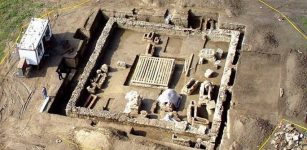Gungnir: Odin’s Magical Weapon That Provoked Or Reduced Conflicts In Norse Mythology
A. Sutherland - AncientPages.com - Among many colorful epithets of the great god, Odin was "Lord of the Spear." Odin owned Gungnir (in Old Norse means "swaying one"), a magical weapon that was unstoppable in its fight and governed the fortunes of war.
Credit: Stock Adobe - bourbonbourbon
This divine weapon would quickly strike whatever he aimed at, and it always flew straight to its target and never missed it.
Brokk and Eitri were well-known craftsmen among the dwarves.
According to Snorri's Edda, Gungnir, the ship Skidbladnir, and the goddess Siv's golden hair were manufactured at the request of Loki by the dwarf artisans Brokk and Eitri. They were sons of Ivaldi and lived in the underground cave in Svartalfheim.
Another version says that after drinking from Mimir's Well, Odin broke off a branch of the sacred tree Yggdrasil, which overshadowed the spring, and made his favorite weapon - the spear Gungnir.
In 'Sigrdrivomal,' a part of the Poetic Edda text in Codex Regius, a sailor mentions that Odin carved runes on Gungnir's cape, and they held magical powers.
 Odin with his spear, Gungnir. Sculpture by Lee Lawrie, Library of Congress
Odin with his spear, Gungnir. Sculpture by Lee Lawrie, Library of Congress
Sometimes, Odin entrusted to Hermod's care the precious spear Gungnir, bidding him to cast it over the combatants' heads about to engage in battle.
As the god of war, Odin usually carried the infallible Gungnir spear in his hand, and this fantastic weapon was so sacred that an oath sworn upon its point could never be broken.
Gungnir, which Odin used on the battlefield, symbolized the initiation of war. He threw it above the heads of the army of enemies. Legends say that if they fell, they became an offering to Odin. Warriors killed by a spear became part of the Einherjar, his troop of warriors in Asgard.
Left: Odin, god of war; Right: 10th-century panel from a Viking-era cross on the Isle of Man. It depicts Odin with his spear and a raven on his shoulder; they meet the wolf Fenrir, and this monstrous creature will devour them.
Gungnir was slender and very strong, and it became Odin's favorite weapon, which the god of war and magic used to provoke or reduce disagreements and conflicts.
Odin cast his spear during the war between the Aesir and the Vanir, and his skills were unlimited. The battle raged until both armies grew tired of the slaughter. But amazingly, neither side could win or lose, so this old tradition continued for a long time.
According to an old tradition, Norse warriors threw their spears at the start of a battle to invoke Odin's protection in war.
This particular spear is of great importance at Ragnarok, the battle on the Last Day. Odin's magic weapon Gungnir and Draupnir ('Dripper'), a fabulous golden ring from which eight equally heavy rings drip every ninth night, are essential attributes for Odin's ability to uphold his power and position as king of the Aesir.
Part of helmet, thin, pressed bronze plate. Found in Vendel. Turning time. The figure possibly represents Odin. Source: Oscar Montelius, Om lifvet i Sverige under hednatiden (Stockholm 1905) s.98 - Public Domain
There are several versions of how Odin obtained the mighty and sacred Gungnir. According to one myth, dwarves forged it from sunlight as a gift to Odin. Another tale says Gungnir was among several objects forged by the dwarves as part of a contest arranged by the trickster god of Norse mythology, Loki.
Then, Loki gave it to Odin, saying:
"I take this spear called Gungnir and give it to you. It is a unique spear in that when aimed and thrown, it never misses its mark. And any oaths sworn with a hand upon its point cannot be broken."
Written by – A. Sutherland AncientPages.com Staff Writer
Updated on January 11, 2024
Copyright © AncientPages.com All rights reserved. This material may not be published, broadcast, rewritten or redistributed in whole or part without the express written permission of AncientPages.com
Expand for referencesReferences:
Gaiman N. Norse Mythology
Hedeager L. Iron Age Myth and Materiality
More From Ancient Pages
-
 New Inscriptions, Gold And Paint Showed Thanks To Restoration In Temple Of Edfu
Archaeology | Sep 20, 2024
New Inscriptions, Gold And Paint Showed Thanks To Restoration In Temple Of Edfu
Archaeology | Sep 20, 2024 -
 Why Was Ayllu Very Important For The Inca People?
Ancient History Facts | Feb 19, 2019
Why Was Ayllu Very Important For The Inca People?
Ancient History Facts | Feb 19, 2019 -
 Ancestral Home Of All Humans Revealed Through World’s Largest Genome Reconstruction Of Our Ancestors
Archaeology | Jan 3, 2023
Ancestral Home Of All Humans Revealed Through World’s Largest Genome Reconstruction Of Our Ancestors
Archaeology | Jan 3, 2023 -
 On This Day In History: Shakespeare’s King Lear Performed Before The Court Of King James I – On Dec 26, 1606
News | Dec 26, 2016
On This Day In History: Shakespeare’s King Lear Performed Before The Court Of King James I – On Dec 26, 1606
News | Dec 26, 2016 -
 Historic Shipwreck Margaret A. Muir Found In Lake Michigan, Wisconsin
Archaeology | Jul 29, 2024
Historic Shipwreck Margaret A. Muir Found In Lake Michigan, Wisconsin
Archaeology | Jul 29, 2024 -
 Encounter Between Neanderthals And Homo Sapiens – Genome Study Traces The History
DNA | Oct 18, 2023
Encounter Between Neanderthals And Homo Sapiens – Genome Study Traces The History
DNA | Oct 18, 2023 -
 Norwegian Vikings Were Much More Violent Than Their Danish Counterparts, New Study Reveals
Vikings | Aug 29, 2024
Norwegian Vikings Were Much More Violent Than Their Danish Counterparts, New Study Reveals
Vikings | Aug 29, 2024 -
 The Hittites, Mysterious People Of A Thousand Gods – Collapse Of The Hittite Empire
News | Sep 9, 2015
The Hittites, Mysterious People Of A Thousand Gods – Collapse Of The Hittite Empire
News | Sep 9, 2015 -
 Pandavleni Buddhist Caves: Sculptures, Inscriptions And Sophisticated Water Management System
Civilizations | Dec 8, 2016
Pandavleni Buddhist Caves: Sculptures, Inscriptions And Sophisticated Water Management System
Civilizations | Dec 8, 2016 -
 Ambition, Greed And Death: The Roman Roots Of ‘Game Of Thrones’
Featured Stories | Jul 2, 2019
Ambition, Greed And Death: The Roman Roots Of ‘Game Of Thrones’
Featured Stories | Jul 2, 2019 -
 Knights Templar’s Mysterious Underground Chambers Hidden In The Caynton Caves Discovered
Archaeology | Apr 13, 2021
Knights Templar’s Mysterious Underground Chambers Hidden In The Caynton Caves Discovered
Archaeology | Apr 13, 2021 -
 Archaeology Illuminates Chinese Businesses In Eugene
Archaeology | May 23, 2022
Archaeology Illuminates Chinese Businesses In Eugene
Archaeology | May 23, 2022 -
 Why Is A Snake Symbol Of Medicine And Pharmacies?
Ancient History Facts | Jan 15, 2018
Why Is A Snake Symbol Of Medicine And Pharmacies?
Ancient History Facts | Jan 15, 2018 -
 Ancient Objects Used In Unknown Celtic Ritual Discovered In Polish Lake
Archaeology | Jul 22, 2024
Ancient Objects Used In Unknown Celtic Ritual Discovered In Polish Lake
Archaeology | Jul 22, 2024 -
 Puzzling Water Glyphs Of The American Southwest – Ancient Astronomical Symbols, Directional Signs Or Something Else?
Featured Stories | Apr 15, 2023
Puzzling Water Glyphs Of The American Southwest – Ancient Astronomical Symbols, Directional Signs Or Something Else?
Featured Stories | Apr 15, 2023 -
 7,000-Year-Old Grains Hints At Origin Of Swiss Pile Dwellings
Archaeology | Mar 3, 2022
7,000-Year-Old Grains Hints At Origin Of Swiss Pile Dwellings
Archaeology | Mar 3, 2022 -
 New Clues May Explain Collapse Of Ancient City Teotihuacan In Mexico
Archaeology | Sep 22, 2022
New Clues May Explain Collapse Of Ancient City Teotihuacan In Mexico
Archaeology | Sep 22, 2022 -
 9,600-Year-Old Permament Settlement And Daily Tools Discovered In Turkey
Archaeology | Sep 2, 2022
9,600-Year-Old Permament Settlement And Daily Tools Discovered In Turkey
Archaeology | Sep 2, 2022 -
 Viminacium Ancient Roman Camp: Sarcophagus With Skeletons, Rich Grave Goods Found In Serbia
Archaeology | Jun 5, 2018
Viminacium Ancient Roman Camp: Sarcophagus With Skeletons, Rich Grave Goods Found In Serbia
Archaeology | Jun 5, 2018 -
 Ashur – First Capital And Powerful Religious Center Of The Assyrian Empire
Featured Stories | Jun 28, 2019
Ashur – First Capital And Powerful Religious Center Of The Assyrian Empire
Featured Stories | Jun 28, 2019



